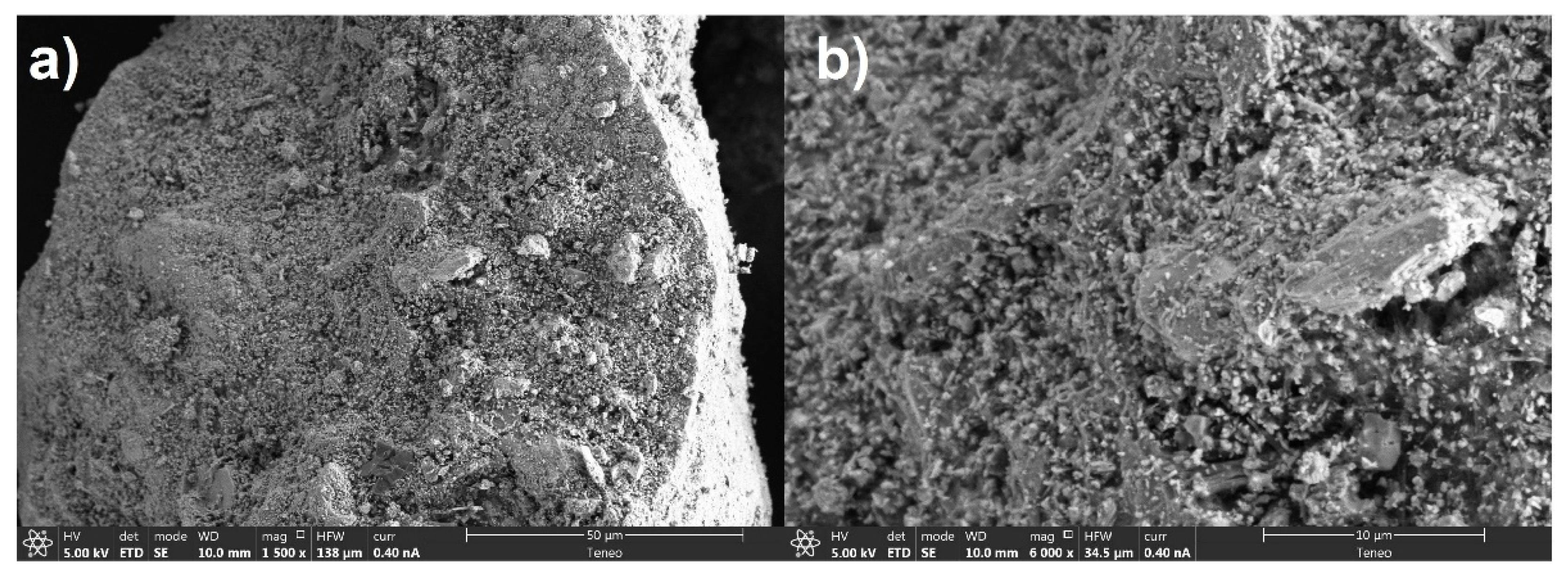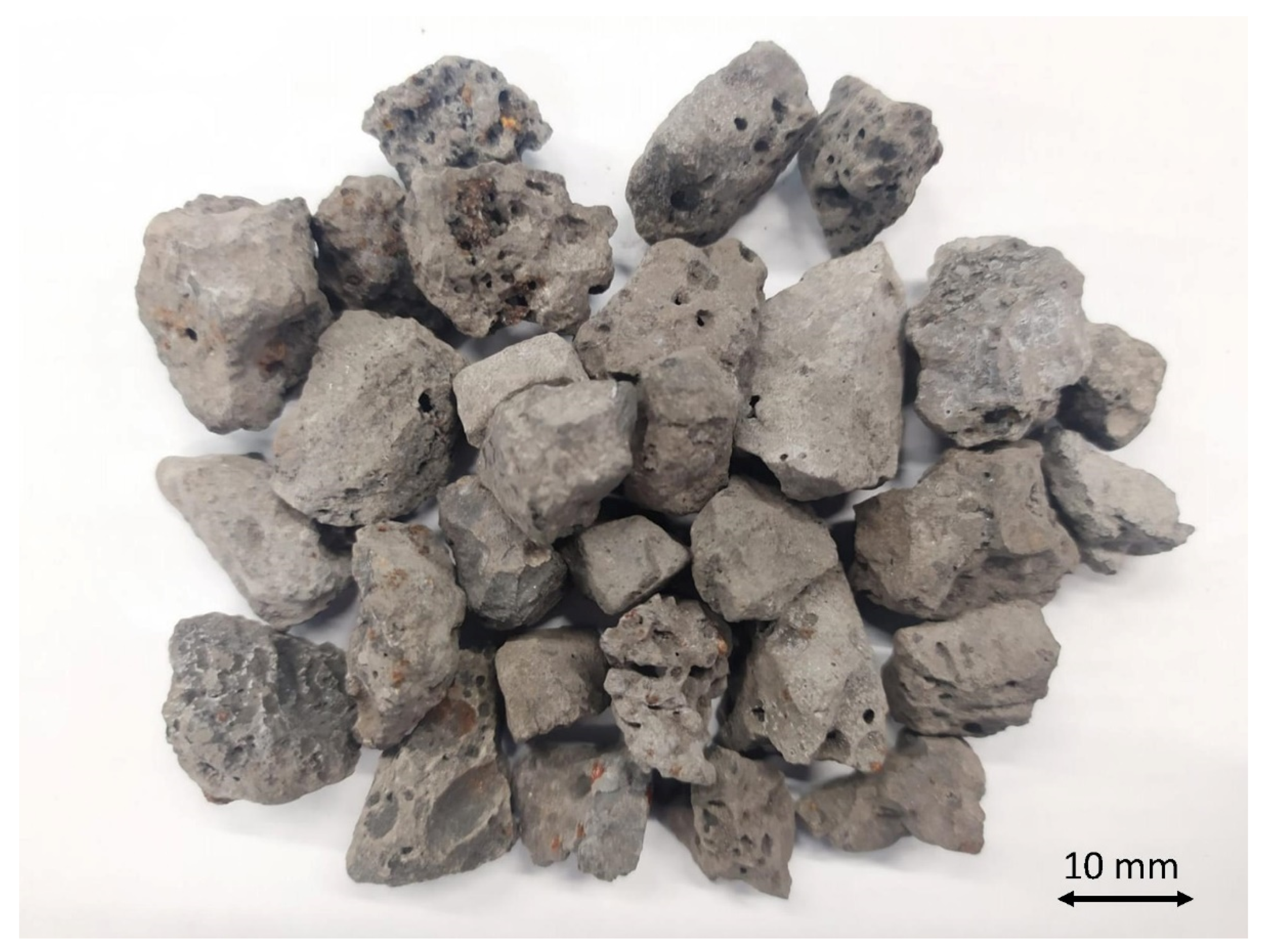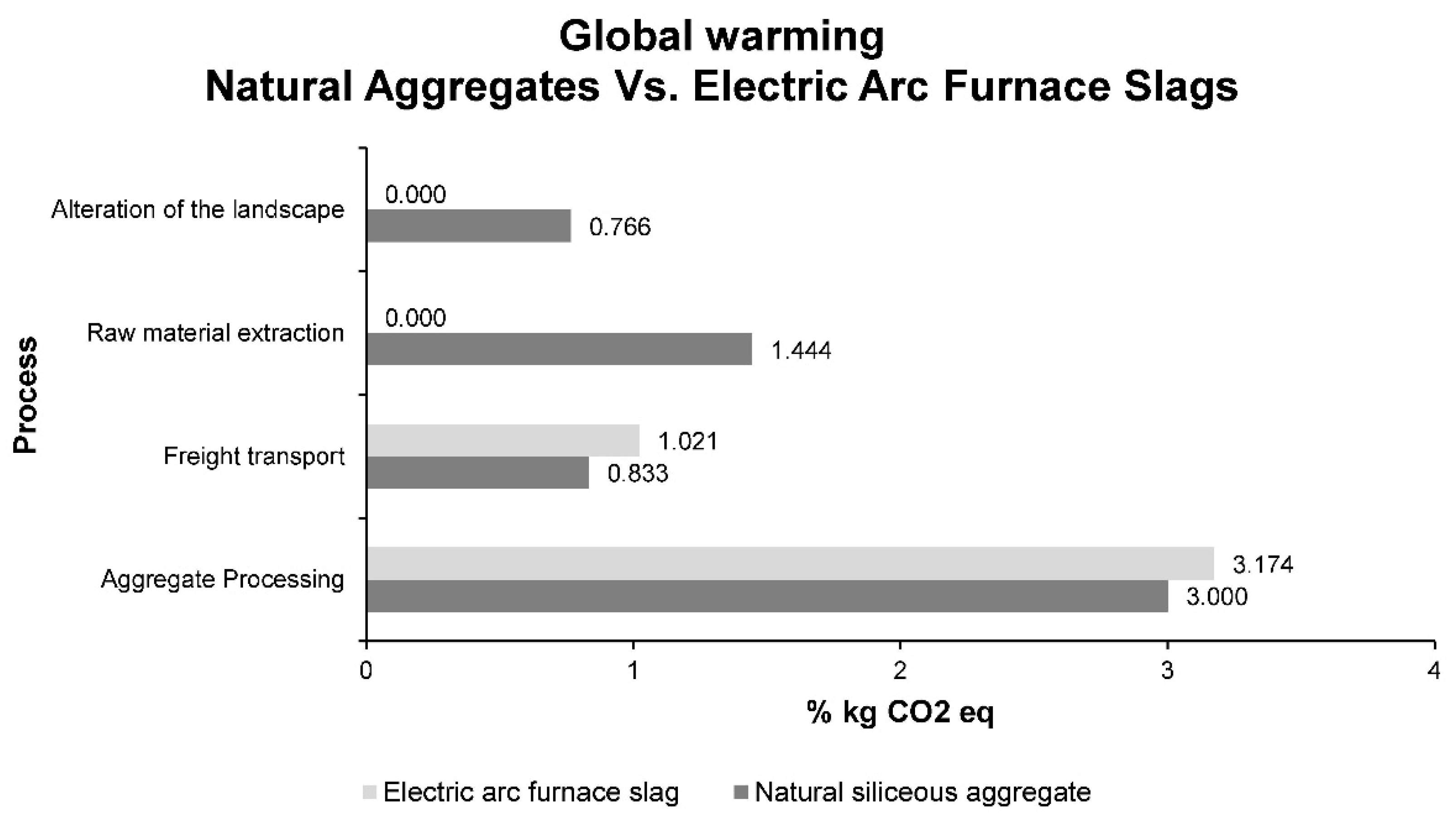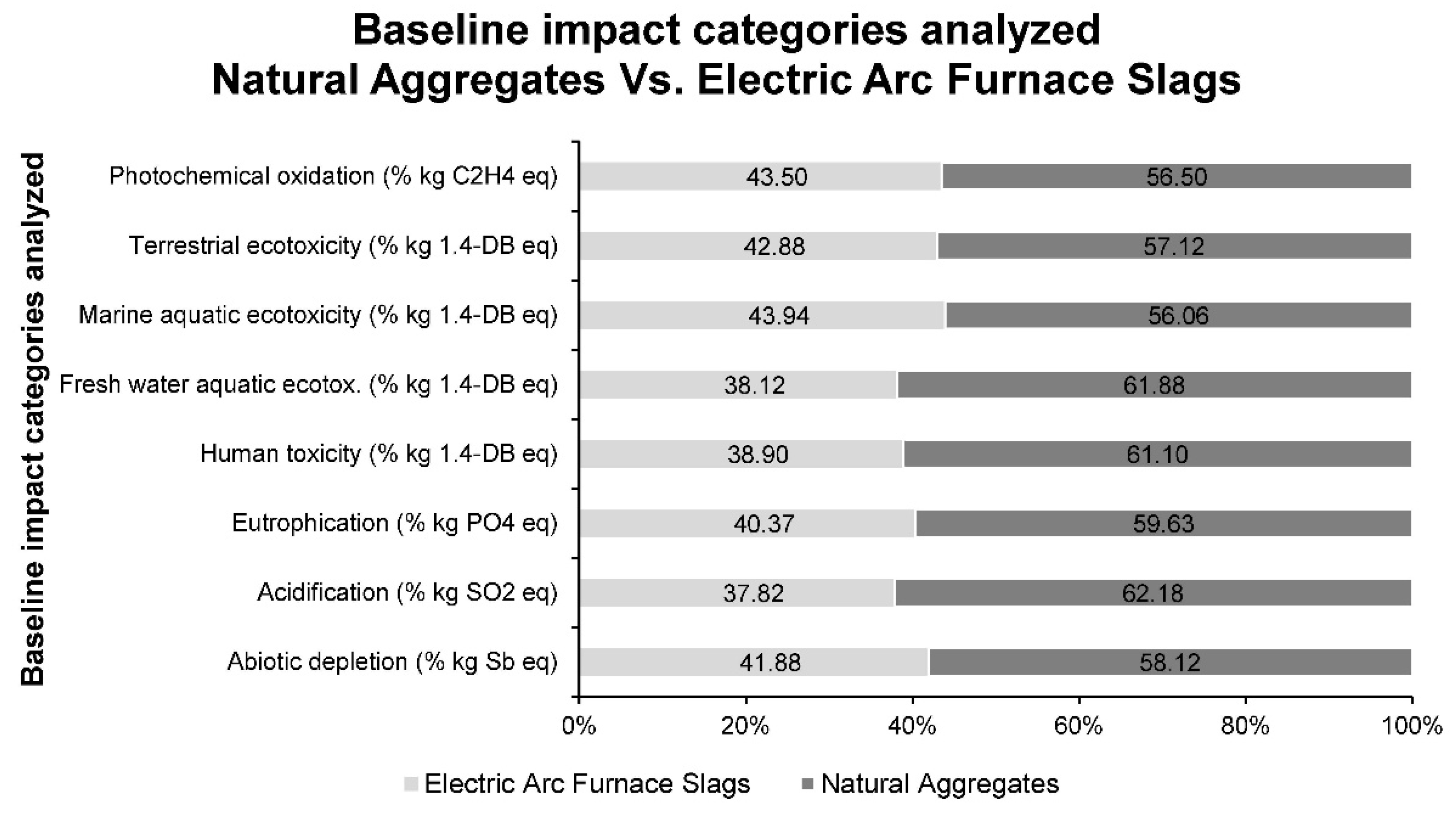Determination of the Chemical, Physical and Mechanical Characteristics of Electric Arc Furnace Slags and Environmental Evaluation of the Process for Their Utilization as an Aggregate in Bituminous Mixtures
Abstract
1. Introduction
2. Materials and Methods
2.1. Materials
Electric Arc Furnace Slags
2.2. Methodology
2.2.1. Characterization of the Electric Arc Furnace Slags (EAFS)
2.2.2. Life Cycle Assessment of the Electric Arc Furnace Slags in Comparison with Conventional Aggregates
- Alteration of the landscape, geology and hydrogeology. The work of extracting materials is very polluting. In addition, the extraction directly from the physical environment produces a series of environmental impacts in the area of extraction which must be considered. Firstly, and as a previous task, any type of vegetation must be eliminated and a suitable terrain must be provided for the extraction of aggregates. This stage, therefore, has a significant influence on the vegetation and fauna, as well as on the various ground water and surface water flows.
- Raw material extraction. The various tasks involved in extracting the material produce a significant environmental impact on the physical environment in which they are carried out. Firstly, the continuous transport of machinery and the creation of roads for this equipment have an impact on greenhouse gas emissions and fauna. At the same time, it is usual to use explosives to obtain smaller fragments that can be treated for the manufacture of aggregates. These explosives produce a series of afflictions on the environment such as: seismic waves, air waves and dust. All these materials, after blasting, must be loaded by equipment that consumes fossil fuels in large trucks to be transported to aggregate processing plants, with the consequent emission of greenhouse gases.
- Freight transport. Vehicles with a high loading capacity and powered in most cases by fossil fuels transport the material loaded in the previous stages to the aggregate processing plant. This transport, through different routes made for the vehicles, produces a series of considerable greenhouse gas emissions. Therefore, for this study, a distance of 20 km has been taken as the distance between the extraction site and the aggregate processing plant. This distance is limiting in aggregate processing plant.
- Aggregate processing. Aggregates produced in quarries have very variable dimensions. There are large blocks of dimensions that are not acceptable for bituminous mixtures and even very small particles. Therefore, it is essential to process these materials in order to obtain a classification according to particle size. With the particle size classification, bituminous mixtures can be made by combining different stockpiles. As mentioned, the work of processing aggregates takes care of size reduction and classification according to particle size for their benefit in bituminous mixtures. This essential stage produces the final marketable material, and is therefore considered the last phase.
- On the one hand, there is a diversity of publications in various fields that have used this type of methodology and that have obtained adequate results.
- On the other hand, it possesses a high versatility, identifying different environmental factors that are affected by one process or another.
- Finally, the values obtained are based on statistics referenced at a European and even world level. Therefore, the extrapolation of the results is feasible in several countries.
- Empirical data measured directly from the industries producing road aggregates.
- Bibliographic data from various authors worldwide and in Europe.
- Different prestigious databases such as Ecoinvent v.3.2 (Ecoinvent, Zurich, Switzerland).
3. Results
3.1. Characterization of the Electric Arc Furnace Slags (EAFS)
3.2. Life Cycle Assessment of the Electric Arc Furnace Slags in Comparison with Conventional Aggregates
4. Conclusions
- The chemical composition of the slag reflects the composition of an inorganic material, the main chemical elements being calcium, iron, silicon, aluminum manganese and magnesium. The rest of the elements are available in low proportion. In addition, the main compounds are iron oxides, iron and manganese oxides and wollastonite, in smaller proportion. Therefore, the chemical composition shows a stable material without changes in shape or texture due to its contact with the environment.
- Electric arc furnace slags have a higher density than a conventional aggregate, greater than 3 t/m3. In turn, the shape of the particles makes the slag an ideal material for use in bituminous mixtures dedicated to high traffic roads, as has also been reflected in the sand equivalent test, (77 ± 2)%. The higher water absorption, WA24 = (3.33 ± 0.08)% conditions the absorption of a greater percentage of bitumen in the mixture, but does not imply a lower resistance to thermal fatigue.
- The high resistance to fragmentation of the electric arc furnace slags, (13 ± 1)%, and the resistance to thermal fatigue, (0.551 ± 0.016)% show the excellent quality of this material for use in bituminous mixtures. In addition, the polished stone value, 58 ± 1, shows the high resistance of the slag to polishing by the continuous passage of vehicles, maintaining the micro-texture of the aggregate throughout its working life.
- The concentrations of heavy metals in the leachate from electric arc furnace slags are lower than those set by Spanish regulations. Therefore, its use for bituminous mixtures is acceptable without producing environmental pollution, even more so when it is enveloped by bitumen, making it difficult to leach.
- The processing of electric arc furnace slags for use as aggregates for bituminous mixtures produces a reduction in environmental impact compared to the processing of natural siliceous aggregates of similar quality, with kg CO2 equivalent emissions of 4.194 and 6.043, respectively. It produces a reduction of 30% of kilograms of CO2 equivalent by using the slags; therefore, it is an environmentally friendly option.
Author Contributions
Funding
Institutional Review Board Statement
Informed Consent Statement
Data Availability Statement
Acknowledgments
Conflicts of Interest
References
- Yumashev, A.; Ślusarczyk, B.; Kondrashev, S.; Mikhaylov, A. Global Indicators of Sustainable Development: Evaluation of the Influence of the Human Development Index on Consumption and Quality of Energy. Energies 2020, 13, 2768. [Google Scholar] [CrossRef]
- Mohd Hasan, M.R.; You, Z. Estimation of cumulative energy demand and green house gas emissions of ethanol foamed WMA using life cycle assessment analysis. Constr. Build. Mater. 2015, 93, 1117–1124. [Google Scholar] [CrossRef]
- Guo, C.; Xu, J.; Yang, L.; Guo, X.; Liao, J.; Zheng, X.; Zhang, Z.; Chen, X.; Yang, K.; Wang, M. Life cycle evaluation of greenhouse gas emissions of a highway tunnel: A case study in China. J. Clean. Prod. 2019, 211, 972–980. [Google Scholar] [CrossRef]
- Menegaki, M.E.; Kaliampakos, D.C. European aggregates production: Drivers, correlations and trends. Resour. Policy 2010, 35, 235–244. [Google Scholar] [CrossRef]
- Turk, J.; Mauko Pranjić, A.; Mladenovič, A.; Cotič, Z.; Jurjavčič, P. Environmental comparison of two alternative road pavement rehabilitation techniques: Cold-in-place-recycling versus traditional reconstruction. J. Clean. Prod. 2016, 121, 45–55. [Google Scholar] [CrossRef]
- Demirbas, A. Waste management, waste resource facilities and waste conversion processes. Energy Convers. Manag. 2011, 52, 1280–1287. [Google Scholar] [CrossRef]
- Alkins, A.E.; Lane, B.; Kazmierowski, T. Sustainable Pavements. Transp. Res. Rec. J. Transp. Res. Board 2008, 2084, 100–103. [Google Scholar] [CrossRef]
- Morseletto, P. Targets for a circular economy. Resour. Conserv. Recycl. 2020, 153, 104553. [Google Scholar] [CrossRef]
- Anthonissen, J.; Van den bergh, W.; Braet, J. Review and environmental impact assessment of green technologies for base courses in bituminous pavements. Environ. Impact Assess. Rev. 2016, 60, 139–147. [Google Scholar] [CrossRef]
- Vaiana, R.; Balzano, F.; Iuele, T.; Gallelli, V. Microtexture Performance of EAF Slags Used as Aggregate in Asphalt Mixes: A Comparative Study with Surface Properties of Natural Stones. Appl. Sci. 2019, 9, 3197. [Google Scholar] [CrossRef]
- Abousnina, R.; Manalo, A.; Ferdous, W.; Lokuge, W.; Benabed, B.; Saif Al-Jabri, K. Characteristics, strength development and microstructure of cement mortar containing oil-contaminated sand. Constr. Build. Mater. 2020, 252, 119155. [Google Scholar] [CrossRef]
- Siddika, A.; Mamun, M.A.A.; Ferdous, W.; Saha, A.K.; Alyousef, R. 3D-printed concrete: Applications, performance, and challenges. J. Sustain. Cem. Mater. 2020, 9, 127–164. [Google Scholar] [CrossRef]
- Proctor, D.M.; Fehling, K.A.; Shay, E.C.; Wittenborn, J.L.; Green, J.J.; Avent, C.; Bigham, R.D.; Connolly, M.; Lee, B.; Shepker, T.O.; et al. Physical and chemical characteristics of blast furnace, basic oxygen furnace, and electric arc furnace steel industry slags. Environ. Sci. Technol. 2000, 34, 1576–1582. [Google Scholar] [CrossRef]
- Yildirim, I.Z.; Prezzi, M. Chemical, mineralogical, and morphological properties of steel slag. Adv. Civ. Eng. 2011, 2011, 463638. [Google Scholar] [CrossRef]
- Sideris, K.K.; Tassos, C.; Chatzopoulos, A.; Manita, P. Mechanical characteristics and durability of self compacting concretes produced with ladle furnace slag. Constr. Build. Mater. 2018, 170, 660–667. [Google Scholar] [CrossRef]
- Hosseini, S.; Soltani, S.M.; Fennell, P.S.; Choong, T.S.Y.; Aroua, M.K. Production and applications of electric-arc-furnace slag as solid waste in environmental technologies: A review. Environ. Technol. Rev. 2016, 5, 1–11. [Google Scholar] [CrossRef]
- Luz, A.P.; Tomba Martinez, A.G.; López, F.; Bonadia, P.; Pandolfelli, V.C. Slag foaming practice in the steelmaking process. Ceram. Int. 2018, 44, 8727–8741. [Google Scholar] [CrossRef]
- Sosa, I.; Thomas, C.; Polanco, J.A.; Setién, J.; Tamayo, P. High Performance Self-Compacting Concrete with Electric Arc Furnace Slag Aggregate and Cupola Slag Powder. Appl. Sci. 2020, 10, 773. [Google Scholar] [CrossRef]
- Lee, J.-Y.; Choi, J.-S.; Yuan, T.-F.; Yoon, Y.-S.; Mitchell, D. Comparing Properties of Concrete Containing Electric Arc Furnace Slag and Granulated Blast Furnace Slag. Materials 2019, 12, 1371. [Google Scholar] [CrossRef] [PubMed]
- Terrones-Saeta, J.M.; Suárez-Macías, J.; Iglesias-Godino, F.J.; Corpas-Iglesias, F.A. Development of High Resistance Hot Mix Asphalt with Electric Arc Furnace Slag, Ladle Furnace Slag, and Cellulose Fibers from the Papermaking Industry. Appl. Sci. 2021, 11, 399. [Google Scholar] [CrossRef]
- Terrones-Saeta, J.M.; Suárez-Macías, J.; Iglesias-Godino, F.J.; Corpas-Iglesias, F.A. Evaluation of the Use of Electric Arc Furnace Slag and Ladle Furnace Slag in Stone Mastic Asphalt Mixes with Discarded Cellulose Fibers from the Papermaking Industry. Metals 2020, 10, 1548. [Google Scholar] [CrossRef]
- Lizárraga, J.M.; Gallego, J. Self-Healing Analysis of Half-Warm Asphalt Mixes Containing Electric Arc Furnace (EAF) Slag and Reclaimed Asphalt Pavement (RAP) Using a Novel Thermomechanical Healing Treatment. Materials 2020, 13, 2502. [Google Scholar] [CrossRef]
- Terrones-Saeta, J.M.; Suárez-Macías, J.; Iglesias-Godino, F.J.; Corpas-Iglesias, F.A. Development of Porous Asphalt with Bitumen Emulsion, Electric arc Furnace Slag and Cellulose Fibers for Medium Traffic Roads. Minerals 2020, 10, 872. [Google Scholar] [CrossRef]
- Skaf, M.; Pasquini, E.; Revilla-Cuesta, V.; Ortega-López, V. Performance and Durability of Porous Asphalt Mixtures Manufactured Exclusively with Electric Steel Slags. Materials 2019, 12, 3306. [Google Scholar] [CrossRef]
- Terrones-Saeta, J.M.; Suárez-Macías, J.; Iglesias-Godino, F.J.; Corpas-Iglesias, F.A. Development of Slurry Surfacing with Electric Arc Furnace Slag for Pavements with Friction Problems. Minerals 2020, 10, 878. [Google Scholar] [CrossRef]
- Oluwasola, E.A.; Hainin, M.R.; Aziz, M.M.A. Evaluation of asphalt mixtures incorporating electric arc furnace steel slag and copper mine tailings for road construction. Transp. Geotech. 2015, 2, 47–55. [Google Scholar] [CrossRef]
- Zheng, X.; Easa, S.M.; Ji, T.; Jiang, Z. Incorporating uncertainty into life-cycle sustainability assessment of pavement alternatives. J. Clean. Prod. 2020, 264, 121466. [Google Scholar] [CrossRef]
- Sas, W.; Głuchowski, A.; Radziemska, M.; Dzięcioł, J.; Szymański, A. Environmental and Geotechnical Assessment of the Steel Slags as a Material for Road Structure. Materials 2015, 8, 4857–4875. [Google Scholar] [CrossRef] [PubMed]
- Jullien, A.; Proust, C.; Yazoghli-Marzouk, O. LCA of alternative granular materials—Assessment of ecotoxicity and toxicty for road case studies. Constr. Build. Mater. 2019, 227, 116737. [Google Scholar] [CrossRef]
- Willms, T.; Echterhof, T.; Steinlechner, S.; Aula, M.; Abdelrahim, A.; Fabritius, T.; Mombelli, D.; Mapelli, C.; Preiss, S. Investigation on the Chemical and Thermal Behavior of Recycling Agglomerates from EAF by-Products. Appl. Sci. 2020, 10, 8309. [Google Scholar] [CrossRef]






| Sample | Nitrogen, % | Carbon, % | Hydrogen, % | Sulfur, % |
|---|---|---|---|---|
| EAFS | 0.005 ± 0.001 | 0.164 ± 0.003 | 0.044 ± 0.001 | 0.000 ± 0.001 |
| Compound | wt, % | Est.Error |
|---|---|---|
| CaO | 31.75 | 0.23 |
| Fe2O3 | 21.96 | 0.21 |
| SiO2 | 17.52 | 0.19 |
| Al2O3 | 12.26 | 0.16 |
| MnO | 6.15 | 0.12 |
| MgO | 5.05 | 0.11 |
| Cr2O3 | 2.73 | 0.08 |
| TiO2 | 0.955 | 0.047 |
| BaO | 0.658 | 0.033 |
| P2O5 | 0.319 | 0.016 |
| SrO | 0.186 | 0.0093 |
| V2O5 | 0.159 | 0.0079 |
| Nb2O5 | 0.0659 | 0.0033 |
| S | 0.0645 | 0.0032 |
| ZrO2 | 0.0551 | 0.0028 |
| K2O | 0.0289 | 0.0016 |
| CuO | 0.0254 | 0.0017 |
| ZnO | 0.0245 | 0.0016 |
| Co3O4 | 0.0147 | 0.0016 |
| Eu2O3 | 0.0137 | 0.0065 |
| WO3 | 0.0104 | 0.0031 |
| Y2O3 | 0.0018 | 0.0005 |
| Test | Standard | Value/Unit |
|---|---|---|
| Particle density (coarse aggregate), t/m3 | UNE-EN 1097-6 | 3.13 ± 0.05 |
| Particle density (fine aggregate), t/m3 | UNE-EN 1097-6 | 3.34 ± 0.07 |
| Water absorption WA24, % | UNE-EN 1097-6 | 3.33 ± 0.08 |
| Sand Equivalent, % | UNE-EN 933-8 | 77 ± 2 |
| Broken surfaces (coarse aggregate), % | UNE-EN 933-5 | 100 ± 1 |
| Flakiness index, % | UNE-EN 933-3 | 0 ± 1 |
| Test | Standard | Value/Unit |
|---|---|---|
| Resistance to fragmentation, % | UNE-EN 1097-2 | 13 ± 1 |
| Resistance to freezing and thawing, % | UNE-EN 1367-1 | 0.551 ± 0.016 |
| Polished stone value | UNE-EN 1097-8 | 58 ± 1 |
| Element | EAFS, mg/kg | Maximum Limits, mg/kg |
|---|---|---|
| Ba | 2.132 ± 0.061 | 17.000 |
| Cd | 0.000 ± 0.001 | 0.009 |
| Cr | 0.237 ± 0.006 | 0.500 |
| Mo | 0.078 ± 0.002 | 0.500 |
| Ni | 0.004 ± 0.001 | 0.400 |
| Pb | 0.006 ± 0.001 | 0.500 |
| Se | 0.035 ± 0.001 | 0.100 |
| V | 1.175 ± 0.029 | 1.300 |
| Zn | 0.112 ± 0.003 | 1.200 |
| As | 0.000 ± 0.001 | 0.500 |
| Cu | 0.105 ± 0.003 | 2.000 |
| Hg | 0.000 ± 0.001 | 0.010 |
| Sb | 0.012 ± 0.001 | 0.060 |
| Impact Category | Unit | Natural Aggregate | EAFS |
|---|---|---|---|
| Abiotic depletion | kg Sb eq | 0.043 | 0.031 |
| Acidification | kg SO2 eq | 0.033 | 0.020 |
| Eutrophication | kg PO4 eq | 0.011 | 0.007 |
| Human toxicity | kg 1.4-DB eq | 4.922 | 3.032 |
| Fresh water aquatic ecotox | kg 1.4-DB eq | 1.664 | 1.304 |
| Marine aquatic ecotoxicity | kg 1.4-DB eq | 3407.349 | 2557.654 |
| Terrestrial ecotoxicity | kg 1.4-DB eq | 0.017 | 0.013 |
| Photochemical oxidation | kg C2H4 eq | 0.002 | 0.001 |
Publisher’s Note: MDPI stays neutral with regard to jurisdictional claims in published maps and institutional affiliations. |
© 2021 by the authors. Licensee MDPI, Basel, Switzerland. This article is an open access article distributed under the terms and conditions of the Creative Commons Attribution (CC BY) license (http://creativecommons.org/licenses/by/4.0/).
Share and Cite
Terrones-Saeta, J.M.; Suárez-Macías, J.; Moreno-López, E.R.; Corpas-Iglesias, F.A. Determination of the Chemical, Physical and Mechanical Characteristics of Electric Arc Furnace Slags and Environmental Evaluation of the Process for Their Utilization as an Aggregate in Bituminous Mixtures. Materials 2021, 14, 782. https://doi.org/10.3390/ma14040782
Terrones-Saeta JM, Suárez-Macías J, Moreno-López ER, Corpas-Iglesias FA. Determination of the Chemical, Physical and Mechanical Characteristics of Electric Arc Furnace Slags and Environmental Evaluation of the Process for Their Utilization as an Aggregate in Bituminous Mixtures. Materials. 2021; 14(4):782. https://doi.org/10.3390/ma14040782
Chicago/Turabian StyleTerrones-Saeta, Juan María, Jorge Suárez-Macías, Evaristo Rafael Moreno-López, and Francisco Antonio Corpas-Iglesias. 2021. "Determination of the Chemical, Physical and Mechanical Characteristics of Electric Arc Furnace Slags and Environmental Evaluation of the Process for Their Utilization as an Aggregate in Bituminous Mixtures" Materials 14, no. 4: 782. https://doi.org/10.3390/ma14040782
APA StyleTerrones-Saeta, J. M., Suárez-Macías, J., Moreno-López, E. R., & Corpas-Iglesias, F. A. (2021). Determination of the Chemical, Physical and Mechanical Characteristics of Electric Arc Furnace Slags and Environmental Evaluation of the Process for Their Utilization as an Aggregate in Bituminous Mixtures. Materials, 14(4), 782. https://doi.org/10.3390/ma14040782









